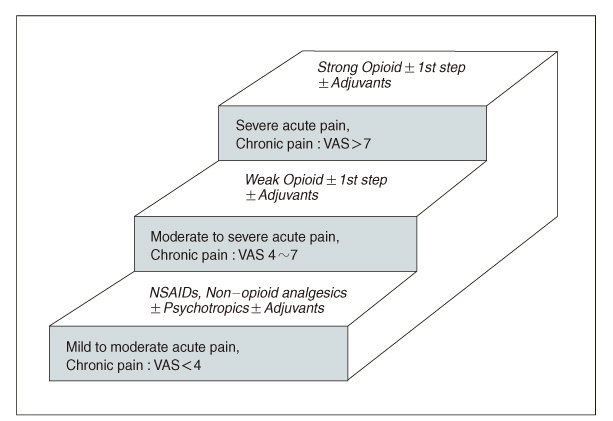J Korean Med Assoc.
2006 Aug;49(8):665-673. 10.5124/jkma.2006.49.8.665.
Analgesics for Lower Back Pain
- Affiliations
-
- 1Department of Anesthesiology and Pain Medicine, Yonsei University College of Medicine, Korea. ywleepain@yumc.yonsei.ac.kr
- KMID: 2184695
- DOI: http://doi.org/10.5124/jkma.2006.49.8.665
Abstract
- Lower back pain is one of the major health problems in the general population. The causes of lower back pain are heterogeneous and its treatment is complicated. The administration of oral analgesics is the basic step in the treatment of acute somatic pain. Most physicians advocate the three step analgesic ladder method, and NSAIDs are a mainstay of therapy for both acute and chronic lower back pain. Among the patients with chronic pain narcotics with psychotropic drugs have a better efficacy especially in the patients with neuropathic pain. Successful long-term analgesia is a challenge for physicians. The administration of a single agent or a combination of the above drugs to the specifically individualized patients could improve the function and quality of life and achieve the last goal of treatment of chronic lower back pain.
Keyword
MeSH Terms
Figure
Cited by 1 articles
-
Comparison of the Efficacy and Safety Profiles of a Pelubi Sustained Release Tab Versus a Pelubi Tab in Patients with Chronic Back Pain: A Randomized, Double-Blind, Multi-Institution Phase III Study
Ki Taek Kim, Tae Kyun Kim, Ji Woong Choi, Jae Sung Ahn, Young Do Koh, Young Woo Kim, Jung Hee Lee
J Korean Soc Spine Surg. 2016;23(2):84-92. doi: 10.4184/jkss.2016.23.2.84.
Reference
-
1. Long DM, BenDebba M, Torgerson WS, Boyd RJ, Dawson EG, Watts C, et al. Persistent back pain and sciatica in the United States: patient characteristics. J Spinal Disord. 1996. 9:40–58.2. Roberts LJ, Morrow JD. Hardman JG, Limbird LE, editors. Analgesic-antipyretic and antiinflammatory agents and drugs employed in the treatment of gout. The pharmacological basis of therapeutics. 2001. 10th ed. New York: McGraw-Hill;687–732.3. Savage R. Cyclo-oxygenase-2 inhibitors: when should they be used in the elderly? Drugs Aging. 2005. 22:185–200.4. Nielsen OH, Ainsworth M, Csillag C, Rask-Madsen J. Systematic review: coxibs, nonsteroidal anti-inflammatory drugs or no cyclooxygenase inhibitors in gastroenterological high-risk patients? Aliment Pharmacol Ther. 2006. 23:27–33.
Article5. Preston MR, Walter MF, McNulty HP, Lockwood SF, Byun J, Jacob RF, et al. Rofecoxib increases susceptibility of human LDL and membrane lipids to oxidative damage: a mechanism of cardiotoxicity. J Cardiovasc Pharmacol. 2006. 47:Suppl 1. S7–S14.6. Walt RP. Misoprostol for the treatment of peptic ulcer and antiinflammatory- drug-induced gastroduodenal ulceration. N Engl J Med. 1992. 327:1575–1580.
Article7. Kuffner EK, Dart RC, Bogdan GM, Hill RE, Casper E, Darton L. Effect of maximal daily doses of acetaminophen on the liver of alcoholic patients: a randomized, double blind, placebo-controlled trial. Arch Intern Med. 2001. 161:2247–2252.
Article8. Malonne H, Coffiner M, Fontaine D, Sonet B, Sereno A, Vanderbist F, et al. Long-term tolerability of tramadol LP, a new once-daily formulation, in patients with osteoarthritis or low back pain. J Clin Pharm Ther. 2005. 30:113–120.
Article9. Raffa R. Pharmacologic aspects of successful long-term analgesia. Clin Rheumatol. 2006. 25:Suppl 1. S9–S15.10. Peloso PM, Fortin L, Beaulieu A, Kamin M, Rosenthal N. Analgesic efficacy and safty of tramadol/acetaminophen combination tablets (Ultracet) in treatment of chronic lowback pain: a multicenter, outpatient, randomized, double blind, placebo controlled trial. J Rheumatol. 2004. 31:2454–2463.11. Langford RM. Pain management today-what have we learned? Clin Rheumatol. 2006. 25:Suppl 1. S2–S8.
Article12. Jones D, Story DA. Serotonin syndrome and the anesthetist. Anaesth Intensive Care. 2005. 33:181–187.13. Ballantyne JC, Mao J. Opioid therapy for Chronic Pain. N Engl J Med. 2003. 349:1943–1953.
Article14. Mahowald ML, Singh JA, Majeski P. Opioid use by patients in an orthopedics spine clinic. Arthritis Rheum. 2005. 52:6–10.
Article15. Furian AD, Sandoval JA, Mailis-Gagnon A, Tunks E. Opioids for chronic noncancer pain: a meta-analysis of effectiveness and side effects. CMAJ. 2006. 174:1589–1594.
Article16. Eisenberg E, McNicol ED, Carr DB. Efficacy of Systemic review of randomized controlled trials. Eur J Pain. 2006. Epub ahead of print.17. Mystakidou K, Parpa E, Tsilika E, Marvromati A, Smyrniotis V, Vlahos L, et al. Long-term management of noncancer pain with transdermal therapeutic system-fentanyl. J Pain. 2003. 4:298–306.
Article18. Kerns JW, White A, Nashelsky J, Sherman S. Does psychiatric treatment help patients with intractable chronic pain? J Fam Pract. 2006. 55:235–236.19. Staiger TO, Gaster B, Sullivan MD, Deyo RA. Systematic review of antidepressants in the treatment of chronic low back pain. Spine. 2003. 28:2540–2545.
Article20. Baron R, Binder A. How neuropathic is sciatica? The mixed pain concept. Orthopade. 2004. 33:568–567.21. Maizels M, McCarberg B. Antidepressants and antiepileptic drugs for chronic non-cancer pain. Am Fam Physician. 2005. 71:483–490.22. Jackson JL, Browning R. Impact of national low back pain guidlines on clinical practice. South Med J. 2005. 98:139–143.23. Toth PP, Urtis J. Commonly used muscle relaxant therapies for acute low back pain: a review of carisoprodol, cyclobenzaprine hydrochloride, and metaxalone. Clin Ther. 2004. 26:1355–1367.
Article24. Beebe FA, Barkin RL, Barkin S. A clinical and pharmacologic review of skeletal muscle relaxants for musculoskeletal conditions. Am J Ther. 2005. 12:151–171.
Article
- Full Text Links
- Actions
-
Cited
- CITED
-
- Close
- Share
- Similar articles
-
- Endometriosis and ovarian cyst misconceived as a failed back surgery syndrome: A case report
- Analgesic therapy according to disease specific pathophysiology
- Attention to postoperative pain control in children
- The Effect of Diclofenac Sodium on Uncontrolled Postoperative Back Pain by IV-PCA
- Management of Chronic Pain


